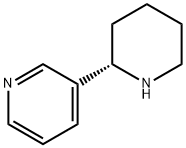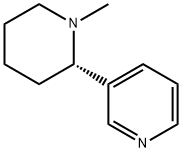(-)-ANABASINE
- CAS NO.:494-52-0
- Empirical Formula: C10H14N2
- Molecular Weight: 162.23
- MDL number: MFCD00871391
- EINECS: 207-791-3
- SAFETY DATA SHEET (SDS)
- Update Date: 2024-11-19 20:33:22

What is (-)-ANABASINE?
Chemical properties
Pale Yellow Oil
The Uses of (-)-ANABASINE
(S)-ANABASINE is used as a kind of Nicotinic receptor agonist.
The Uses of (-)-ANABASINE
Anabasine occurs in the tobacco speciesNicotiana glauca, Anabasis aphylla L.,Chenopodiaceae, and Solanaceae. It is usedas an insecticide and as a metal anticorrosiveagent.
What are the applications of Application
(S)-Anabasine is An agonist to the Nicotinic receptor
Definition
ChEBI: The (S)-enantiomer of anabasine.
Health Hazard
The acute toxic symptoms include increasedsalivation, confusion, disturbed vision, photophobia,nausea, vomiting, diarrhea, respiratorydistress, and convulsions. It causesrespiratory muscle stimulation similar to thatcaused by lobeline. An oral lethal dose indogs is 50 mg/kg. A subcutaneous lethaldose in guinea pigs is 10 mg/kg.
Biological Activity
Anabasine ((S)-Anabasine) is an alkaloid, a component of tobacco. Anabasine is a botanical insecticide that acts as a pan-agonist of nicotinic acetylcholine receptors (nAChRs). Anabasine induces depolarization in TE671 cells endogenously expressing human myogenic nAChRs (EC50=0.7 μM).
Safety Profile
Poison by ingestion,subcutaneous, and intravenous routes. Moderately toxicby skin contact. An experimental teratogen. Insecticide.Acute and subacute toxicity: increased salivation, vertigo,confusion, disturbed vision and hearing, photophobia,cold ext
in vivo
Anabasine significantly reverses the impairment at the 0.2 mg/kg (p<0.05) and 2 mg/kg doses (p<0.025). Anabasine does not have any significant effects on response latency when administered alone. The 0.06 mg/kg Anabasine dose, in fact, significantly (p<0.05) exacerbates the dizocilpine-induced impairment. None of these Anabasine doses affects choice accuracy on their own. Individual dose comparisons show that the 0.06 mg/kg Anabasine dose plus dizocilpine (6.7±2.6) causes a significant (p<0.05) increase in non-response trials compare with dizocilpine alone (2.1±0.8).
Properties of (-)-ANABASINE
| Melting point: | 9°C |
| Boiling point: | 270-272°C |
| alpha | D20 -83.1° |
| Density | 1,0455 g/cm3 |
| refractive index | 1.5430 |
| Flash point: | 93°C |
| storage temp. | 2-8°C |
| solubility | DMSO : 100 mg/mL (616.41 mM) |
| pka | 8.98±0.10(Predicted) |
| form | Liquid |
| color | Colorless to light yellow |
| Merck | 14,619 |
| BRN | 82637 |
| CAS DataBase Reference | 494-52-0(CAS DataBase Reference) |
| NIST Chemistry Reference | Pyridine, 3-(2-piperidinyl)-, (S)-(494-52-0) |
| EPA Substance Registry System | Anabasine (494-52-0) |
Safety information for (-)-ANABASINE
Computed Descriptors for (-)-ANABASINE
New Products
4-AMINO-TETRAHYDRO-PYRAN-4-CARBOXYLIC ACID HCL 4-(Dimethylamino)tetrahydro-2H-pyran-4-carbonitrile 4-Aminotetrahydropyran-4-carbonitrile Hydrochloride (R)-3-Aminobutanenitrile Hydrochloride 3-((Dimethylamino)methyl)-5-methylhexan-2-one oxalate 1,4-Dioxa-8-azaspiro[4.5]decane 5-Bromo-2-nitropyridine Nimesulide BP Aceclofenac IP/BP/EP Diclofenac Sodium IP/BP/EP/USP Mefenamic Acid IP/BP/EP/USP Ornidazole IP Diclofenac Potassium THOMAIND PAPER PH 2.0 TO 4.5 1 BOX BUFFER CAPSULE PH 9.2 - 10 CAP SODIUM CHLORIDE 0.1N CVS ALLOXAN MONOHYDRATE 98% PLATINUM 0.5% ON 3 MM ALUMINA PELLETS (TYPE 73) LITHIUM AAS SOLUTION 2-Bromo-1-(bromomethyl)-3-chloro-5-nitrobenzene 2-Bromo-3-nitroaniline N-(3-Hydroxypropyl)-N-methylacetamide 3-Bromo-6-chloropyridazine 4-ethyl-3-nitrobenzoic acidRelated products of tetrahydrofuran


![3-[(2S)-PIPERIDIN-2-YL]PYRIDINE HYDROCHLORIDE](https://img.chemicalbook.in/StructureFile/ChemBookStructure8/GIF/CB5371222.gif)


![(S)-2-(3,4,5,6-TETRAHYDRO-2H-[2,3']BIPYRIDINYL-1-YL)-ETHANOL](https://img.chemicalbook.in/StructureFile/ChemBookStructure21/GIF/CB2812957.gif)
![4-METHOXY-3-[(S)-1-(3,4,5,6-TETRAHYDRO-2H-[2,3']BIPYRIDINYL-1-YL)METHYL]-BENZALDEHYDE](https://img.chemicalbook.in/StructureFile/ChemBookStructure21/GIF/CB8841067.gif)

You may like
-
 1-Methyl-6-oxo-1,6-dihydropyridazine-3-carbonitrile 98%View Details
1-Methyl-6-oxo-1,6-dihydropyridazine-3-carbonitrile 98%View Details
99903-60-3 -
 88491-46-7 98%View Details
88491-46-7 98%View Details
88491-46-7 -
 1823368-42-8 98%View Details
1823368-42-8 98%View Details
1823368-42-8 -
 2-(3-(tert-butyl)phenoxy)-2-methylpropanoic acid 1307449-08-6 98%View Details
2-(3-(tert-butyl)phenoxy)-2-methylpropanoic acid 1307449-08-6 98%View Details
1307449-08-6 -
 Ethyl 3-(furan-2-yl)-3-hydroxypropanoate 25408-95-1 98%View Details
Ethyl 3-(furan-2-yl)-3-hydroxypropanoate 25408-95-1 98%View Details
25408-95-1 -
 2-Chloro-5-fluoro-1-methoxy-3-methylbenzene 98%View Details
2-Chloro-5-fluoro-1-methoxy-3-methylbenzene 98%View Details
1805639-70-6 -
 1784294-80-9 98%View Details
1784294-80-9 98%View Details
1784294-80-9 -
 Lithium ClavulanateView Details
Lithium ClavulanateView Details
61177-44-4